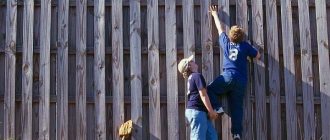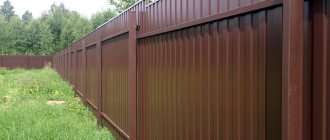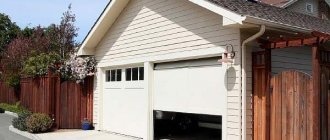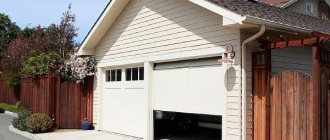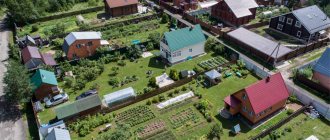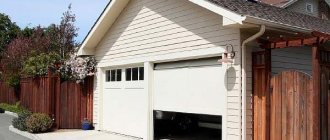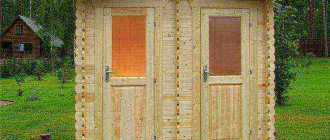When building a fence for your summer cottage or private house, you must follow the rules for installing a fence between neighbors, the law of the Russian Federation. This is necessary, first of all, to comply with sanitary standards, fire safety rules and the convenience of others. However, the rules for installing a fence are often ignored, which leads to conflicts and litigation between neighbors.
A clear example of ignoring rules and regulations
Installing a fence between neighbors in the private sector
The main purpose of a fence in a private house is to define the boundaries between neighbors’ plots and only then to protect the property. Therefore, it is necessary to take into account the interests of neighbors and the rules for installing a fence between plots, and not just your preferences.
Contradictions between neighbors can arise not only at the time of installation of a fence or fencing. They occur when the fence has already been in place for a long time. This may simply end in a quarrel between neighbors, or it may lead to the payment of a fine and the demolition of the fence. To prevent this from happening, you should adhere to existing recommendations and installation rules.
First of all, before installing the fence, you should carefully read all the regulatory documents. In particular, calculate the boundaries of land plots down to centimeters.
To ensure that possible disagreements are eliminated, it is recommended that you discuss the boundaries of private property with your neighbors in advance.
For reliability, it is best to sign an act on the boundaries of the site in SNT or individual housing construction.
If you cannot independently determine the boundaries of the site according to the rules, you should seek help from a surveyor. He will be guided not only by documents, but will also independently study the area, accurately measure the areas and issue a conclusion.
Example of a blind fence
You can act on its basis without fear that the construction of a fence is taking place outside the law and regulations.
However, it is no longer possible to erect a fence simply at will. First, you will need to apply for permission from the department of urban planning and architecture of the locality. This can cause new difficulties if there is a water supply or electrical communications system on the territory.
These recommendations should not be neglected, as well as other rules for installing a fence between neighbors in private houses. If neighbors complain and any violations are found, the fence may be dismantled.
What to do if a neighbor installed a fence on my property
Returning to his dacha after a winter break, a person discovers that an enterprising neighbor has demolished the old fence and installed a new fence, simultaneously moving it 2-3 meters deeper into the plot belonging to the unlucky summer resident.
The situation is quite common, but under no circumstances should you grab an ax and destroy an unauthorized building. You need to act exclusively within the framework of the law, and first of all turn to the land survey plan, which shows the territorial demarcation in detail. If a neighbor has really encroached on your territory, he can be required to move the installed fence and restore the old fence.
If the invader does not listen to the arguments, you can contact the territorial office of Rosreestr. This is a government body responsible for control over land plots. An inspector will come out to check the complaint and carefully examine the documents of both sites.
If the fact of an offense is confirmed, a corresponding act is drawn up, and the neighbor who arbitrarily violated the border is issued an order to restore territorial integrity.
If this measure is ignored, you can go to court with a claim to release the land from illegal use.
What could a fence look like?
You can independently choose the material from which the fence between neighbors will be made, and its color. This is not regulated by anyone or anything. The main rule is that the installation does not darken the area, has an aesthetic appearance on both sides, and can also withstand any load.
Recommended material for fencing between neighbors
It is recommended to use for installing a fence:
- chain-link mesh (long service life and easy installation);
- wood (aesthetics, environmental friendliness and practicality);
- welded fence;
- profile pipe at a summer cottage in SNT or in a private house;
- forged metal structures in a village or city.
The photo shows an example of a recommended fence for a private home.
The welded fence was installed according to all the rules
To make a steel fence last longer, it can be coated with protective enamel during installation. In turn, painting a wooden fence should be done after antiseptic treatment. But this is also not regulated by any rules. If the owner of the site is embarrassed by the gaps, they can be reduced by planting climbing plants along the length.
What the law says
Many developers wonder whether it is necessary to go through all the stages? In theory - no, in practice it is necessary. Otherwise, a person who has not received approval may become a victim of circumstances. On the one hand, a lawsuit from neighbors, in which, unfortunately, he will not emerge victorious; on the other hand, a fine from government agencies for lack of a building permit in the amount of 3 to 5 minimum wages, which currently ranges from 33,840 to 56400 rubles. To avoid problems, it is better to act within the framework of existing legislation.
Norms and rules for installing fencing in SNT between neighbors
There is no law regulating the height and position of the fence. However, a gardening non-profit partnership must rely on the rules for installing a fence prescribed in SNiP 30-02-97. The last changes were made there in 2001, and then in 2021.
Building codes
The document establishes the following requirements for installing a fence between neighbors in SNT:
- the height should not exceed 1.5 meters in the summer cottage;
- a blind fence can only be installed on the side of the roadway, ravine or street;
- the partition between two sections must necessarily be translucent (transparent, in the form of a mesh or lattice);
- installation of blind fencing between areas is possible by mutual agreement.
The document also states that the construction of a solid fence on four sides will negatively affect the microclimate of the site. Therefore, for example, a solid fence made of unedged boards or a fence made of corrugated board is not the best choice.
The height of the fence can be discussed with neighbors in the village. If they don't object, installing higher barriers is not prohibited. You will need to draw up and sign a deed, which will serve as evidence in court if any disagreements arise in the future.
Standard distances from courtyard buildings and plantings to the fence
It is important to understand that SNiP 30-02-97 as amended in 2021 and SP 53.13330.2019 are not law, these are only recommendations for gardening partnerships.
Attention should be paid to the norms adopted by local governments: decisions differ by region.
For example, in the Volgograd region it is allowed to install a fence up to 220 cm in height, provided that the fence is translucent. If the owner wants to install a blind fence without gaps, he will have to be content with a maximum height of 75 cm.
Rules for the location of buildings and their distance from neighboring areas
All buildings, structures and outbuildings located on a personal plot must comply with sanitary requirements and fire safety standards. In particular, the following distances must be maintained between a residential building and other buildings:
- outbuildings and storage areas for household waste - 8-15 meters;
- bathhouse - 5-8 meters;
- well - 8-10 meters.
There are no separate standards for garages or car parks under a canopy, so they can be located on the site at your discretion.
As for the fence, the recommended distances for its installation will look like this:
- tall trees - 4 meters;
- medium-sized trees - 2 meters;
- shrubs - 1 meter;
- residential building - 3 meters;
- outbuildings, pens for livestock or poultry - 4 meters.
Ways to resolve disputes with neighbors
Most often, disagreements arise between neighbors regarding the size of the plot. Everyone is trying to increase their own territory. Sometimes this happens by installing a fence outside your property. To avoid such situations, you should draw up a contract or agreement where all the nuances will be fixed.
This will allow:
- initially clarify all controversial issues;
- have a document that has legal force and is evidence in court;
- stipulate all the consequences of non-compliance with the agreement.
If neighbors refuse to sign this, it is better not to risk it and adhere to the recommendations of SNiP. Otherwise, it will be impossible to prove the existence of an oral agreement in court. If the neighbors did not install the fence according to the rules, and attempts to resolve the situation peacefully did not yield results, you can safely go to court.
However, do not expect the trial to be simple. Determining who is right and who is wrong depends on a large number of factors.
There are issues whose solutions are not described in the legislation.
For example, there are no clear guidelines on who should install the fence between properties. Land owners do this at their own request and discretion. Mutual installation of fencing is also allowed by prior agreement.
The video talks about the standard distances from the fence to the courtyard buildings.
How to write?
Before you begin drawing up a conciliation document, you should consider the following recommendations for its preparation:
- It must be in writing (printed or handwritten) and cannot be considered provided only from the words of neighbors.
- It is provided only by owners of neighboring plots whose interests may be affected by the construction of a fence. It cannot be issued on behalf of their family members, tenants or persons occupying the territory on other grounds.
- Accurate information about the construction initiator, his neighbors, and the land plots themselves is indicated, which will allow them to be easily identified if necessary.
- The date corresponding directly to the date of preparation or signing is indicated.
- It is secured by the personal signatures of all persons indicated in the document.
Contents of the document
The current legislation does not provide for a specific form and requirements for the content of consent from neighbors. However, the document should include the following information:
- Full name, passport details of the owners.
- Addresses of each site.
- Documents confirming the parties' ownership of real estate.
- The fact that neighbors consent to the construction of a fence, indicating its location and specific parameters.
- Additional conditions (for example, sharing the costs of installing fences, etc.)
- Details of witnesses (if they are present when signing the document).
- Date of compilation and personal signatures of all parties present with a transcript.
Consequences of missing a document
Neighbors who consider that the fence between plots does not meet the requirements in terms of height, transparency, location (if any are prescribed in local regulations) may demand:
- Bringing to administrative responsibility and issuing orders from local authorities to eliminate discrepancies in height, transparency or other violations.
- Demolition of the fence in court. The basis for action will be the provisions of Art. 304 of the Civil Code of the Russian Federation, if it can be proven that the presence of a fence violates legal rights and interests (restricts the cultivation of crops due to shading, is located on someone else’s territory).
If you cannot reach an agreement with your neighbors peacefully, it is better to turn to lawyers for help in further actions. They will help you competently file a claim in court, the decision of which will be the legal basis for installing the planned fence.
FOR FREE
- Due to frequent changes in legislation, information sometimes becomes outdated faster than we can update it on the website.
- All cases are very individual and depend on many factors. Basic information does not guarantee a solution to your specific problems.
That's why FREE expert consultants work for you around the clock!
- via the form (below), or via online chat
- Call the hotline:
- Moscow and the Region
- St. Petersburg and region
Source
Sample
The agreement must include the following information:
- details of the parties (full name, passport details, registration address);
- information about rights to a land plot (details of the title document and extracts from the Unified State Register of Real Estate);
- address and area of the site;
- cadastral numbers of plots;
- description of the fence (height, density, location);
- cost of making a fence;
- procedure for distribution of expenses;
- data on the consent of the parties to the installation;
- signatures of the parties.
Sample agreement between neighbors to install a fence

